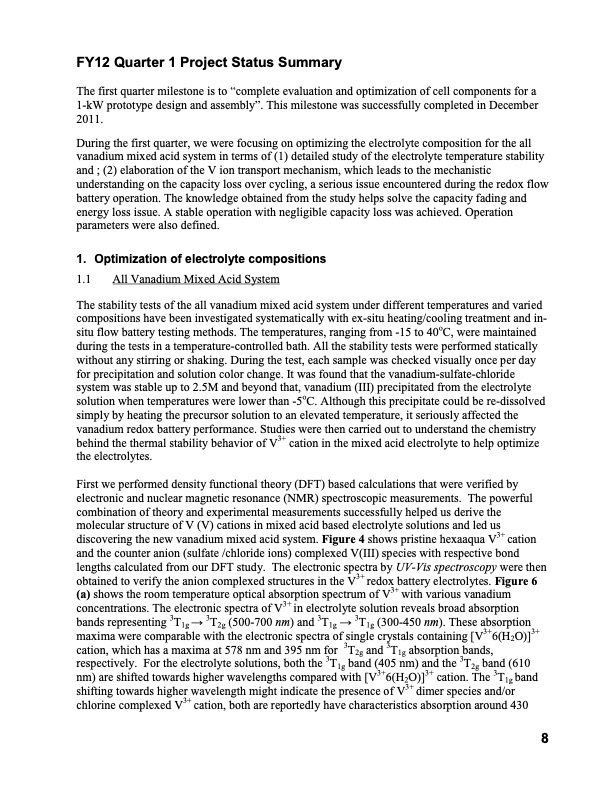
PDF Publication Title:
Text from PDF Page: 011
FY12 Quarter 1 Project Status Summary The first quarter milestone is to “complete evaluation and optimization of cell components for a 1-kW prototype design and assembly”. This milestone was successfully completed in December 2011. During the first quarter, we were focusing on optimizing the electrolyte composition for the all vanadium mixed acid system in terms of (1) detailed study of the electrolyte temperature stability and ; (2) elaboration of the V ion transport mechanism, which leads to the mechanistic understanding on the capacity loss over cycling, a serious issue encountered during the redox flow battery operation. The knowledge obtained from the study helps solve the capacity fading and energy loss issue. A stable operation with negligible capacity loss was achieved. Operation parameters were also defined. 1. Optimizationofelectrolytecompositions 1.1 All Vanadium Mixed Acid System The stability tests of the all vanadium mixed acid system under different temperatures and varied compositions have been investigated systematically with ex-situ heating/cooling treatment and in- situ flow battery testing methods. The temperatures, ranging from -15 to 40oC, were maintained during the tests in a temperature-controlled bath. All the stability tests were performed statically without any stirring or shaking. During the test, each sample was checked visually once per day for precipitation and solution color change. It was found that the vanadium-sulfate-chloride system was stable up to 2.5M and beyond that, vanadium (III) precipitated from the electrolyte solution when temperatures were lower than -5oC. Although this precipitate could be re-dissolved simply by heating the precursor solution to an elevated temperature, it seriously affected the vanadium redox battery performance. Studies were then carried out to understand the chemistry behind the thermal stability behavior of V3+ cation in the mixed acid electrolyte to help optimize the electrolytes. First we performed density functional theory (DFT) based calculations that were verified by electronic and nuclear magnetic resonance (NMR) spectroscopic measurements. The powerful combination of theory and experimental measurements successfully helped us derive the molecular structure of V (V) cations in mixed acid based electrolyte solutions and led us discovering the new vanadium mixed acid system. Figure 4 shows pristine hexaaqua V3+ cation and the counter anion (sulfate /chloride ions) complexed V(III) species with respective bond lengths calculated from our DFT study. The electronic spectra by UV-Vis spectroscopy were then obtained to verify the anion complexed structures in the V3+ redox battery electrolytes. Figure 6 (a) shows the room temperature optical absorption spectrum of V3+ with various vanadium concentrations. The electronic spectra of V3+ in electrolyte solution reveals broad absorption bands representing 3T1g → 3T2g (500-700 nm) and 3T1g → 3T1g (300-450 nm). These absorption maxima were comparable with the electronic spectra of single crystals containing [V3+6(H2O)]3+ cation, which has a maxima at 578 nm and 395 nm for 3T2g and 3T1g absorption bands, respectively. For the electrolyte solutions, both the 3T1g band (405 nm) and the 3T2g band (610 nm) are shifted towards higher wavelengths compared with [V3+6(H2O)]3+ cation. The 3T1g band shifting towards higher wavelength might indicate the presence of V3+ dimer species and/or chlorine complexed V3+ cation, both are reportedly have characteristics absorption around 430 8PDF Image | Redox Flow Batteries for Stationary Electrical Energy Storage

PDF Search Title:
Redox Flow Batteries for Stationary Electrical Energy StorageOriginal File Name Searched:
PNNL-21174.pdfDIY PDF Search: Google It | Yahoo | Bing
Salgenx Redox Flow Battery Technology: Salt water flow battery technology with low cost and great energy density that can be used for power storage and thermal storage. Let us de-risk your production using our license. Our aqueous flow battery is less cost than Tesla Megapack and available faster. Redox flow battery. No membrane needed like with Vanadium, or Bromine. Salgenx flow battery
| CONTACT TEL: 608-238-6001 Email: greg@salgenx.com | RSS | AMP |